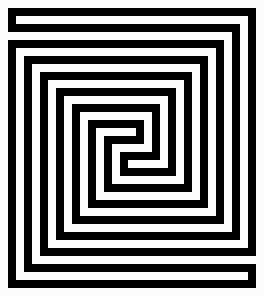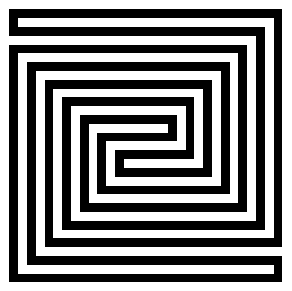OZLOGO
OZ-LOGO
 The Screen Robot = NAKI
The Screen Robot = NAKI
 Block-Recursive Naki
Block-Recursive Naki
OZ-LOGO is the generic name of an algebraic LOGO I implemented for the Australian 8-bit microcomputer the MicroBee in 1983. (The microBee was based on the Z-80 8-bit microprocessor). OZ-LOGO was marketed by Applied Technology on a 2K ROM.
OZ-LOGO actually comprised two algebraic LOGOs.
Line Logo
the user guided about the screen a small robot, like so,  , which
laid a line trail as it went about its screen territory.
The screen roboti/terrapin, called a naki,
could turn through ninety degrees on the command R
The naki had just four possible headings, North (upscreen)
, which
laid a line trail as it went about its screen territory.
The screen roboti/terrapin, called a naki,
could turn through ninety degrees on the command R
The naki had just four possible headings, North (upscreen)  , South
, South  , East
, East  and West
and West  .
.
There were two screen modes -- a full-width srcreen that was 512X512 in naki movement units,
or the half-width mode, where the territory for the naki to roam was just 256x512.
In the half-width mode, the current definitions of the user defineable commands,
V, W, X, Y was displayed, the current dump character was displayed, together with
a "accumulator" termed A.
The classic squiral could be drawn via a macro such as
X=AFR+
Combining several squirals could yield patterns such as:


Maze 1
Maze 2
Maze Crawling
In Line LOGO, the Turtle could not enter a solid area on the screen. There was a built-in maze, and a student could readily
program the naki to traverse the maze, using a macro such as the following:
W = F&R
On the command W, the naki would go forward one-unit -- if it wasn't blocked that is.
If it was blocked, the quantity & would be set to 1, so that is blocked,
the turtle turned righ.
Thus the turtle would keep turning on the spot until the way ahead was not blocked, when it would
go ahead.
Once going straight ahead, the turtle would go ahead until blocked.
The area outside the naki territory was also detected as "blocked"
so the turtle/naki could not go off its territory.
The two patterns above, Maze 1 and Maze 2, were not actually built-into the Applied Technology product.
However, they are worth mentioning as they are in fact intriguing versions
of two figures from the Minsky and Papert book, Perceptrons.
Interpreting black as the blocked area (actually blocked was "white" on the screen,
and placing the naki/turtle within one of the arms -- reveals that
Maze 1 is one worm,
whilst Maze 2 actually involves two (2) non-touching worms.
OZ-LOGO WHAM

The OZ-LOGO Screen Robot (NAKI).
 The OZ-LOGO Screen Robot (NAKI) moved about a tiled region on the screens. The tiles were the same size as the naki itself,
The OZ-LOGO Screen Robot (NAKI) moved about a tiled region on the screens. The tiles were the same size as the naki itself,
 and there were 16x16 of the tiles in the naki territory (for the basic mode). The naki had just four possible headings, North (upscreen)
and there were 16x16 of the tiles in the naki territory (for the basic mode). The naki had just four possible headings, North (upscreen)  , South
, South  , East
, East  and West
and West  .
.
As in line logo - the NAKI could leave a trail - as it moved from tile to tile.
The trail was made up of dump tiles.
The dump tiles used for trail-marking were created as the thumb image of the naki territory, if a cell in the territory was marked, then the corresponding pixel in the thumb was set.
Of course, a tile could be exploded to full-size, using either a standard black tile, or the current dump character.


THE EXPLODED NAKI - - - - - - - - - - - NAKI-RECURSIVE NAKI
Note that in the naki-recursive naki, each block of the naki is similar
to the whole. More generally, for block-oriented fractals, each block
of the fractal is similar to a larger block of the image.
This more general class of block-oriented fractals was available in OZ-LOGO for the 16x16 mode.
In sum. OZ-LOGO was the first demonstration of the concept of block-oriented self-similarity, the basis for fractal image coding.
![]() The Screen Robot = NAKI
The Screen Robot = NAKI![]() Block-Recursive Naki
Block-Recursive Naki  , South
, South  , East
, East  and West
and West  .
.



 The OZ-LOGO Screen Robot (NAKI) moved about a tiled region on the screens. The tiles were the same size as the naki itself,
The OZ-LOGO Screen Robot (NAKI) moved about a tiled region on the screens. The tiles were the same size as the naki itself,
 and there were 16x16 of the tiles in the naki territory (for the basic mode). The naki had just four possible headings, North (upscreen)
and there were 16x16 of the tiles in the naki territory (for the basic mode). The naki had just four possible headings, North (upscreen)  , South
, South  , East
, East  and West
and West  .
.

